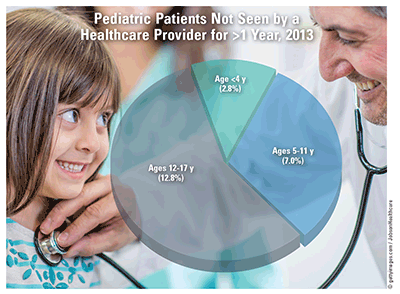US Pharm. 2018;43(5):12.
In 2013, there were 74 million (23.3% of population) children aged <18 years. This is a decline of 17.1% from 1980, including a 28% drop in the number of adolescents aged 15 to 19 years, and there were 4.4% more boys than girls (37.6 million vs. 36 million, respectively). According to the National Center for Health Statistics, parents of 84.2% of children said their child’s health was excellent or very good.

Health Status: With progression from 0 to 4 years of age to 12 to 17 years of age, the proportion of children with good health status increased by 37%, whereas that for children with excellent health fell by 10%. Although 60.5%, 23.7%, and 12.7% of children, respectively, were reported by their parents to be in excellent, very good, or good health, 19.8% had special healthcare needs regarding a chronic medical, behavioral, or developmental condition that affected their functionality.
Symptoms: In all age groups, the chief reason for an office visit was a new health problem. Visits for routine chronic problems were most prevalent among children aged 5 to 14 years (16.8%), and 4% had a flare-up of a chronic problem. However, the rate of preventive-care visits was highest in those aged <1 year (53.7%), followed by 36% fewer visits in those aged 1 to 4 years and 25% fewer visits in those aged 5 to 14 years.
Office Visits: Of the 96% of children who had a usual place of health care, 73.4% went to an HMO/doctor’s office and 25.1% went to a clinic/healthcare center; there were no differences between boys and girls or across age groups in receiving care at these sites. Most office visits (89.4%) were made to a pediatrician, who was the primary care provider (PCP), and 4.7% of visits were made to a non-PCP, but not through referral by another physician. Pediatricians provided or prescribed drugs during 70.2% of office visits made in 2015. In 2012, 171 million visits were made to physicians’ offices by children younger than 18 years of age, for an overall rate of 232 visits per 100 population, and the average time spent with the pediatrician was 21.7 minutes. As patient age increased from <1 year to 14 years, the number of visits per 100 persons per year decreased 60%, from 616.7 to 152.6 visits. Visit rates for well care were lower for children aged 6 to 11 years (31%) and for adolescents aged 12 to 17 years (29%) than for those aged 1 to 5 years (74%). Visit rates for well care and problem-focused care were seven to eight times higher for general pediatricians compared with other PCPs.
To comment on this article, contact rdavidson@uspharmacist.com.






